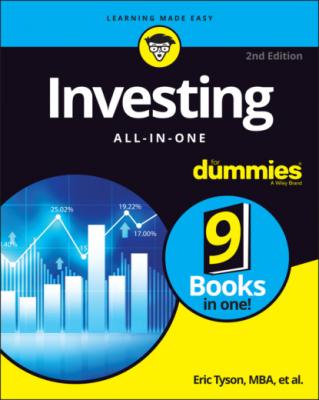Investing All-in-One For Dummies. Eric Tyson
Читать онлайн.| Название | Investing All-in-One For Dummies |
|---|---|
| Автор произведения | Eric Tyson |
| Жанр | Личные финансы |
| Серия | |
| Издательство | Личные финансы |
| Год выпуска | 0 |
| isbn | 9781119873051 |
An important part of making wise investments is knowing when you have enough information to do things well on your own versus when you should hire others. For example, foreign stock markets are generally more difficult to research and understand than domestic markets. Thus, when investing overseas, hiring a good money manager, such as through a mutual or exchange-traded fund, makes more sense than going to all the time, trouble, and expense of picking individual international stocks.
This book is here to give you the information you need to make your way through the complex investment world. The rest of this chapter clears a path so you can identify the major investments, understand the strengths and weaknesses of each, and get information on seeking advice.
Building Wealth with Ownership Investments
If you want your money to grow faster than the rate of inflation over the long term and you don’t mind a bit of a roller-coaster ride from time to time in your investments’ values, ownership investments are for you. Ownership investments are those investments where you own an interest in some company or other asset (such as stock or real estate) that has the ability to generate revenue and profits.
Observing how the world’s richest have built their wealth is enlightening. Not surprisingly, many of the champions of wealth around the globe gained their fortunes largely through owning a piece (or all) of a successful company that they (or others) built.
In addition to owning their own businesses, many well-to-do people have built their nest eggs by investing in real estate and the stock market. With softening housing prices in many regions in the late 2000s, some folks newer to the real estate world incorrectly believe that real estate is a loser, not a long-term winner. Likewise, the stock market goes through down periods but does well over the long term. (See Chapter 2 in Book 1 for the scoop on investment risks and returns.)
And, of course, some people come into wealth through an inheritance. Even if your parents are among the rare wealthy ones and you expect them to pass on big bucks to you, you need to know how to invest that money intelligently.
Not everyone needs to make their money grow, of course. Suppose that you inherit a significant sum and/or maintain a restrained standard of living and work well into your old age simply because you enjoy doing so. In this situation, you may not need to take the risks involved with a potentially faster-growth investment. You may be more comfortable with safer investments, such as paying off your mortgage faster than necessary.
Entering the stock market
Stocks, which are shares of ownership in a company, are an example of an ownership investment. If you want to share in the growth and profits of companies like Skechers (footwear), you can! You simply buy shares of their stock through a brokerage firm. However, even if Skechers makes money in the future, you can’t guarantee that the value of its stock will increase.
Some companies today sell their stock directly to investors, allowing you to bypass brokers. You can also invest in stocks via a stock mutual fund (or an exchange-traded fund), where a fund manager decides which individual stocks to include in the fund.
However, you shouldn’t expect that you can “beat the markets,” and you certainly are not likely to beat the best professional money managers at their own full-time game. This book shows you time-proven, non-gimmicky methods to make your money grow in the stock market as well as in other financial markets. Books 3 and 5 explain more about stocks and mutual funds.
Owning real estate
People of varying economic means build wealth by investing in real estate. Owning and managing real estate is like running a small business. You need to satisfy customers (tenants), manage your costs, keep an eye on the competition, and so on. Some methods of real estate investing require more time than others, but many are proven ways to build wealth.
John, who works for a city government, and his wife, Linda, a computer analyst, have built several million dollars in investment real estate equity (the difference between the property’s market value and debts owed) over the decades. “Our parents owned rental property, and we could see what it could do for you by providing income and building wealth,” says John. Investing in real estate also appealed to John and Linda because they didn’t know anything about the stock market, so they wanted to stay away from it. The idea of leverage — making money with borrowed money — on real estate also appealed to them.
John and Linda bought their first property, a duplex, when their combined income was just $35,000 per year. Every time they moved to a new home, they kept the prior one and converted it to a rental. Now in their 50s, John and Linda own seven pieces of investment real estate and are multimillionaires. “It’s like a second retirement, having thousands in monthly income from the real estate,” says John.
John readily admits that rental real estate has its hassles. “We haven’t enjoyed getting some calls in the middle of the night, but now we have a property manager who can help with this when we’re not available. It’s also sometimes a pain finding new tenants,” he says.
Overall, John and Linda figure that they’ve been well rewarded for the time they spent and the money they invested. The income from John and Linda’s rental properties also allows them to live in a nicer home.
